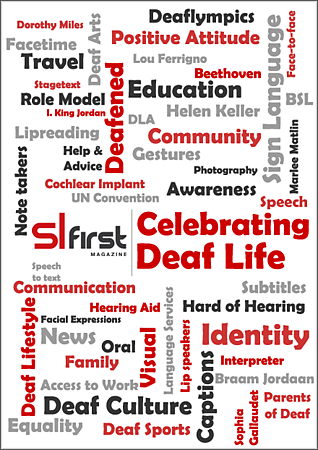Education10th June 2015
Sign Language Helps all Children in Early Years Learning
30 years of research has consistently shown the benefits and finally some educators seem to be listening

Whilst many Deaf educationalists have been arguing for years that it is a good thing for a Deaf child to have early access to sign language to support their language and social development, there seems to be a growing willingness to recognise that learning sign langauge is beneficial to all children. Backed up by research, I for one, am pleased to see this new approach, and perhaps we might finally reach a point where there is widespread recognition that this is a good thing.
 In this second of three articles this week about education, today's article highlights the introduction of sign language to pre-schoolers in America and the increasing use of signs (mostly Makaton) to early years children in the United Kingdom. Following years of stigma being attached to sign language and Makaton by mainstream educators, the rise in acceptability for these to be taught to all children is interesting.
In this second of three articles this week about education, today's article highlights the introduction of sign language to pre-schoolers in America and the increasing use of signs (mostly Makaton) to early years children in the United Kingdom. Following years of stigma being attached to sign language and Makaton by mainstream educators, the rise in acceptability for these to be taught to all children is interesting.
The American example involves pre-school children in an educational setting run by the Moravian Church in Florida. With a long standing interest in education, the Moravian Church offers a teaching programme for children as young as 1, through Pre-K, with the curriculum designed to facilitate the developoment of the whole child (social, intellectual, emotional and physical).
For four years, the curiculum at the school has included sign language, with teachers extolling the virtues of this approach from the day it was introduced. Whilst its introduction follows significant positive research about the educational benefits, teachers at the school report far wider benefits than that.
 Reports from the school suggest that teaching the children sign language has improved all round communication skills, with children able to make themselves understood before their speech has developed. An external teacher visits the school each week to teach sign language, with a sepcial emphasis on the words a child might need to support communication and their early years educational curriculum. Teachers at the school, also learn the same signs, so that they can use the those signs during the week to aid communication and learning.
Reports from the school suggest that teaching the children sign language has improved all round communication skills, with children able to make themselves understood before their speech has developed. An external teacher visits the school each week to teach sign language, with a sepcial emphasis on the words a child might need to support communication and their early years educational curriculum. Teachers at the school, also learn the same signs, so that they can use the those signs during the week to aid communication and learning.
In addition to the benefits above, the sign language teacher, Kim Fries, also believes that learning signs early can cut down on some of the frustrations experienced by many parents when their child is pre-speech and unable to get the parents to understand what they want such as a wanting a drink or something to eat.
For some people involved with early years education, these benefits will come as a surprise. Some will deny them altogether to justify a long-standing stance against teaching children sign language, but for those who are progressive and responsive to new information, a paper that pulls together 30 years of research in this area provides pursuasive evidence of the benfits.
The paper, entitled Signing with Babies and Children: A Summary of Research Findings for Parents and Professionals is a must read for anyone with a vested interest in this field. Below is a brief introduction to the paper.
Until now, if you wanted to get an objective summary of the academic research on signing with babies and children that has been conducted over the past three decades, you would have had to pull together findings from a wide array of disparate and sometimes obscure sources. Now, thanks to Dr. Claire Vallotton, a trusted authority and leading researcher on this topic, you now have access to a comprehensive and concise summary of what research can tell us about the impact of signing on development and learning from early childhood through elementary school.
This white paper is for you - the many parents, teachers, health professionals, social workers, students, and writers who have asked us for unbiased information that can be used to inform practices and shape professional opinions. We are pleased to be sharing this paper with you and we encourage you to pass it along to anyone you think may benefit from it.
 Some of the key findings of the anaysis of the key research show that:
Some of the key findings of the anaysis of the key research show that:
- In the studies that have been done on using signs with infants and young children, none have shown that using signs causes a delay in language development
- Children within families using signs had better language skills than the other groups
- Children whose parents taught them to use signs before they could talk – starting at 11 months old – had better language skills
- The verbal IQs of signing children were 12 points higher on average than their non-signing peers
- Parents report that signing children have fewer tantrums and better social skills, and that both the children and parents are less frustrated
- Early child educators are more responsive to preverbal children when the children are using signs; when children used signs, teachers were better at making eye contact with them, talking to them, being warm and affectionate, and responding to their needs
- Where children who are deaf or hard of hearing are integrated into a classroom with hearing children, the teachers’ use of sign language during instruction seems to benefit both children who are deaf and those who are hearing
Despite generations of cynicism about the benefit of sign language within the educational system in the UK, more schools are now turning to using signs to support the pursuit of its educational goals. In the case of the Worple Primary School in Isleworth, London this has seen this once struggling school transform its fortunes. Just 18 months ago, Ofsted inspectors had been unimpressed with the standard of teaching, describing the school as in need of improvement. After a recent return inspection, the Inspector's were able to rate the school as 'good'.
Seeking to explain the improvement, the head teacher reported that innovative methods to improve literacy, including the use of signing to reinfoce language skills had helped to dramatically improve student attainment.
 Whilst the signs used here were Makaton not British Sign Language, there is little doubt that the teachers involved advocate the use of a signed language to support teaching and learning. Hopefully, they will maintain an ambitious attitude and will move from teaching children makaton to BSL, so that they have a second language skill they will be able to use for the rest of their lives.
Whilst the signs used here were Makaton not British Sign Language, there is little doubt that the teachers involved advocate the use of a signed language to support teaching and learning. Hopefully, they will maintain an ambitious attitude and will move from teaching children makaton to BSL, so that they have a second language skill they will be able to use for the rest of their lives.
For different reasons a school in Birmingham has introduced signed communication to teach youngsters how to develop their language skills. The ARK Rose Primary School in Kings Norton is using Makaton to help youngsters from other countries. More limited than the options using BSL presents, even the use of Makaton has seen children from Somalia, Spain, India and Greece who had no English, able to hold concversations with teachers and other students, just 2 months after starting to learn.
 These welcome steps show progress in the knowledge and understanding of a small number of educators about the benefits sign language presents. It is still early days, but we hope these successes and the transfer of best practice will see wider use of sign language in the future. The best schools will also recognise that the teaching of sign language will also be able to be linked with the 'Finger Gym' discipline that is already widely used to help children with their writing and fine motor skills. The use of finger spelling and finger patterns within BSL provide almost identical opportunites to the Finger Gym, but with the added benefit of developing a language.
These welcome steps show progress in the knowledge and understanding of a small number of educators about the benefits sign language presents. It is still early days, but we hope these successes and the transfer of best practice will see wider use of sign language in the future. The best schools will also recognise that the teaching of sign language will also be able to be linked with the 'Finger Gym' discipline that is already widely used to help children with their writing and fine motor skills. The use of finger spelling and finger patterns within BSL provide almost identical opportunites to the Finger Gym, but with the added benefit of developing a language.
As a teacher of BSL for 20 years, I am, needles to say, an advocate of the language, particularly for deaf children. That leaves articles like this open to suggestions of bias, I recognise that. However, here at SLFirst we want to be balanced and with that in mind, I would welcome any Teacher of the Deaf who advocates that deaf children should not be taught sign language, to write an article setting out the basis for that viewpoint. I can't promise to publish it, but I can promise to give it proper consideration and to publish if it contains the evidence that supports the viewpoint. You can email me directly at sarah@slfirst.co.uk
Like our articles, like our Facebook page to get notification of every new story.
Article by Sarah Lawrence, Editor
posted in Community / Education
10th June 2015





